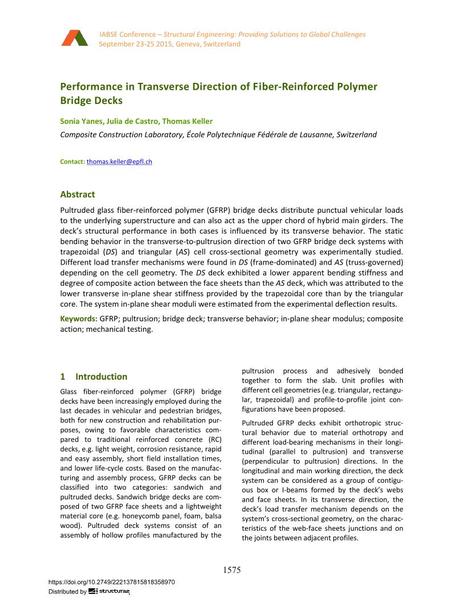Performance in Transverse Direction of Fiber-Reinforced Polymer Bridge Decks

|
|
|||||||||||
Bibliographic Details
| Author(s): |
Sonia Yanes
(Composite Construction Laboratory, École Polytechnique Fédérale de Lausanne, Switzerland)
Julia De Castro (Composite Construction Laboratory, École Polytechnique Fédérale de Lausanne, Switzerland) Thomas Keller (Composite Construction Laboratory, École Polytechnique Fédérale de Lausanne, Switzerland) |
||||
|---|---|---|---|---|---|
| Medium: | conference paper | ||||
| Language(s): | English | ||||
| Conference: | IABSE Conference: Structural Engineering: Providing Solutions to Global Challenges, Geneva, Switzerland, September 2015 | ||||
| Published in: | IABSE Conference Geneva 2015 | ||||
|
|||||
| Page(s): | 1575-1582 | ||||
| Total no. of pages: | 8 | ||||
| Year: | 2015 | ||||
| DOI: | 10.2749/222137815818358970 | ||||
| Abstract: |
Pultruded glass fiber-reinforced polymer (GFRP) bridge decks distribute punctual vehicular loads to the underlying superstructure and can also act as the upper chord of hybrid main girders. The deck’s structural performance in both cases is influenced by its transverse behavior. The static bending behavior in the transverse-to-pultrusion direction of two GFRP bridge deck systems with trapezoidal (DS) and triangular (AS) cell cross-sectional geometry was experimentally studied. Different load transfer mechanisms were found inDS(frame-dominated) andAS(truss-governed) depending on the cell geometry. TheDSdeck exhibited a lower apparent bending stiffness and degree of composite action between the face sheets than theASdeck, which was attributed to the lower transverse in-plane shear stiffness provided by the trapezoidal core than by the triangular core. The system in-plane shear moduli were estimated from the experimental deflection results. |
||||
| Keywords: |
GFRP bridge deck composite action Pultrusion mechanical testing transverse behavior in-plane shear modulus
|
||||
